The 15 Best Tomato Companion Plants to Help Your Crop Thrive

For gardeners who strive to organically nurture and grow productive vegetable gardens, growing companion plants is the best natural resource.
No vegetable garden would be complete without luscious, plump tomatoes. But if you want to reduce your use of herbicides and try a more organic approach, growing tomato companion plants is the ideal solution.
This brings us to the topic of this guide – companion planting for tomato crops. Today, we’ll explore what a companion plant is and how it will help you grow a productive vegetable garden.
What is a Companion Plant?
Companion plants are simply plants grown together to maintain a natural balance in your garden. They generally emit scents that will either deter harmful insects or attract beneficial ones. This, in return, harmonizes the ecosystem in your garden and allows nature to fulfil its role.
Companion planting allows the plants to establish a relationship that benefits mutual development, which includes enhancing nutrient uptake. In addition, herbs have been found to enhance the flavor of crops, with basil being a particularly good choice for tomatoes.
Overall, companion planting is a natural, sustainable technique that helps gardeners improve their crop yields and nurture healthy plants. From effective pest control to disease control. The benefits of companion planting are a tried and trusted method that can complement today’s gardening methods.
Companion Planting For Tomatoes: Why You Should Use Companion Plants
Companion planting for tomatoes is a tried and trusted organic approach to gardening. Unfortunately, tomatoes are known to attract pests and are prone to problems like fungal diseases. So, understanding what a compatible companion plant is, will be the first step towards combating these common issues.
In addition, companion plants compatible with tomatoes provide more than just pest control and disease prevention.
Listed here are some examples of proven benefits of companion growing for tomatoes:
- Better Use of Space: Growing companion plants around your main crop saves vital space that otherwise would have remained unused.
- Retains moisture: Companion plants provide the soil around your main crop with much-needed moisture by preventing moisture evaporation. The roots will also help to break down heavier soils such as clay.
- Weed Control: It’s an effective means of weed control, by providing ground cover and blocking light to any unwanted seedlings.
- Pest Control: They can deter pests with the release of powerful scents that will mask the scent of your tomatoes.
- Disease Awareness: It’s an excellent way to be aware of plant disease. Some herbs or plants will show signs of fungal diseases or poor watering methods before they affect your tomatoes. Basil and cilantro are two herbs that will quickly show signs that all is not well.
- Attracts Beneficial Pollinators: Some species can attract beneficial predators and pollinators. In contrast to deterring unwanted pests, they will attract the beneficial ones too. This will, over a short period of time, be of great benefit to your tomatoes and the rest of your garden.
- Improves Soil Structure: Companion plants can improve both the soil’s and the main crop’s health. For example, oregano will repel pests as well as adding nutrients to the soil. In general, any mentioned companion plant in the following table, will be of benefit. Different plants have different root structures, which will help in the aeration of the soil and release nutrients such as nitrogen.
- Edible Companion Plants: Some plants can serve as a secondary edible crop to enrich your vegetable garden. Lettuce can act as both a living mulch and the roots will help improve the structure of the soil. Radishes, garlic, beans and the flowers of nasturtiums are more examples of edible companion plants.
- Structural Support: Certain companion plants can provide good structural support for your tomatoes. Zucchinis can provide support for shorter varieties of tomatoes. While sunflowers are a good choice for taller growing varieties grown outside. This method of support will require regular monitoring for signs of plant distress. This is because there is more of a risk of overcrowding and poor air circulation. However, don’t be put off, as this can also be a great way to save on space.
- Enhances Flavors: Companion plants, such as basil, chives and oregano, are said to improve the flavor of tomatoes. Scientific evidence is divided here, so let’s go with the culinary experts who swear this method works. What is known for sure is that companion plants aid the health of the soil and deter pests and diseases. This, in turn, results in a healthier plant that has benefitted from an improved uptake of nutrients. This, in my view, surely indicates that companion planting does enhance the flavor of tomatoes.
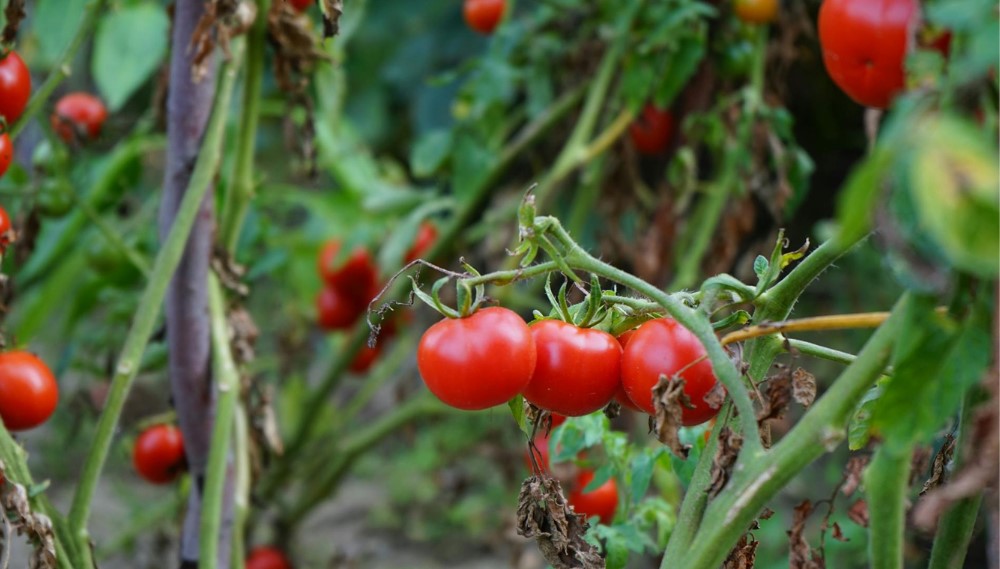
Companion Planting: Basil and Tomatoes
When it comes to companion planting, basil and tomatoes are the perfect combination.
Start growing tomatoes and basil alongside each other, and you’ll immediately notice how well they complement each other.
Firstly, basil is a very helpful pest deterrent. From deterring thrips and aphids to keeping mosquitoes and flies at bay, growing basil creates a reliable shield for your tomato plants.
Although basil and tomatoes share similar growth requirements, basil is not a heavy feeder. This is good as your basil seeds won’t deplete the soil of nutrients that your tomatoes need to produce flavorsome fruit.
As an added bonus, basil plants are reliable indicators of potential diseases. A basil plant’s leaves typically develop powdery mildew, downy mildew, and other diseases before your other crops do.
Basil won’t stop your tomato plants from being prone to diseases like powdery mildew, but they can still serve as an early warning sign of such conditions.
Meanwhile, the large leaves of a tomato plant can protect basil from intense sunlight and heat, by casting shade. This enables the soil around the basil to remain moist.

The Best Companion Plants for Tomatoes
There are many benefits to growing tomatoes alongside companion plants, and there’s more to choose from other than basil. Here are some of the best companion plants for tomatoes that we suggest you try. But not only just for your tomatoes, the following can also benefit other vegetables as well.
Plants to Repel Harmful Insects
Unfortunately, tomato crops are known to attract a vast array of harmful insects. However, this shouldn’t deter you from growing your own tomatoes as paired with the right companion plants, this won’t pose such a problem.
1. Amaranth
| Common Name | Amaranth, Blood Amaranth, Prince’s Feather |
| Botanical Name | Amaranthus cruentus |
| Family | Amaranthaceae |
| Plant Type | Shrub |
| Size | 4-6 ft. tall, 1-2 ft. wide |
| Sun Exposure | Full, Partial |
| Soil Type | Moist, Well-drained |
| Soil pH | Acidic, Neutral |
| Bloom Time | Summer – Autumn |
| Flower Color | Red |
| Hardiness Zones | 2-11 (USDA) |
| Native Area | North America, South America |
| Toxicity | Toxic to pets if digested |
Amaranth is a grain that you can easily grow in your garden. Amaranth attracts beneficial predatory beetles, protecting your tomato crop from harmful insects.
Amaranth is a good neighbour in that it won’t compete with your tomatoes for water or space.
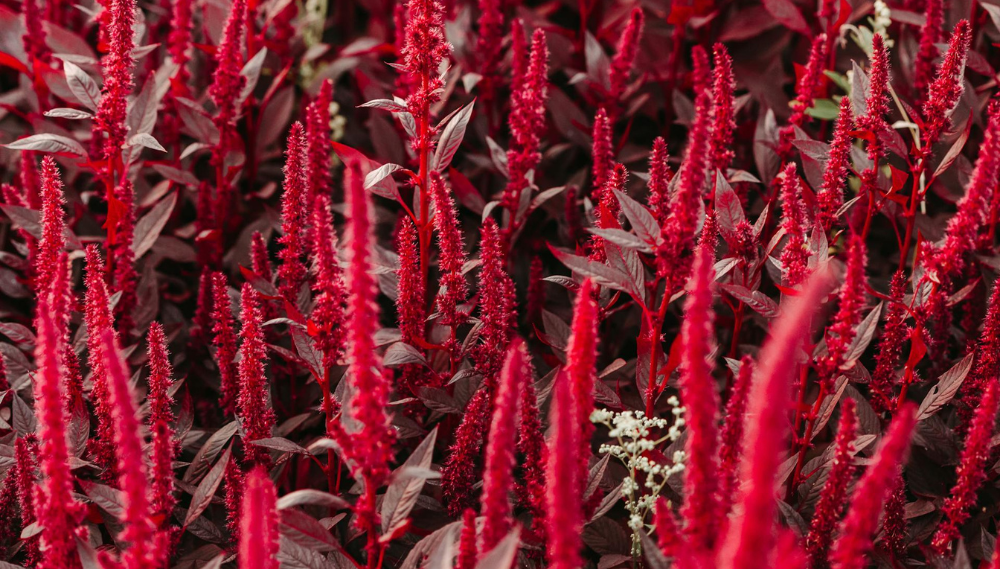
Calendula
| Common Name | Calendula, Pot Marigold, Garden Marigold, Gold Bloom |
| Botanical Name | Calendula officinalis |
| Family | Asteraceae |
| Plant Type | Flower |
| Size | 1-2 ft. tall, 1-2 ft. wide |
| Sun Exposure | Full, Partial |
| Soil Type | Well-drained |
| Soil pH | Slightly Acidic, Neutral |
| Bloom Time | Summer – Early Autumn |
| Flower Color | Yellow and Orange |
| Hardiness Zones | 2-11 (USDA) |
| Native Area | The Mediterranean |
| Toxicity | Non-toxic |
Calendulas, or pot marigolds, have many properties that make them excellent pest-repellants. Firstly, the leaves of calendulas are covered in a sticky residue that not only attracts aphids but also traps them. Aside from being a perfect trap crop, calendulas also sport bright orange/yellow blooms that attract beneficial insects like ladybirds and lacewings.
Calendulas can also repel nematodes, flea beetles, and even rabbits.
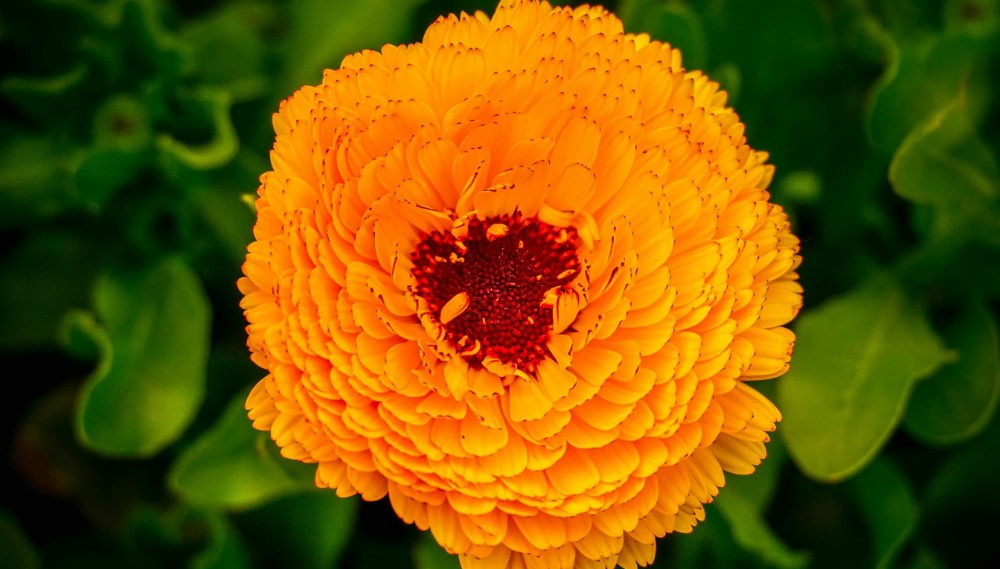
French Marigolds
| Common Name | French Marigolds |
| Botanical Name | Tagetes patula |
| Family | Asteraceae |
| Plant Type | Flower |
| Size | 6-24 in. tall, 6-18 in. wide |
| Sun Exposure | Full |
| Soil Type | Well-drained |
| Soil pH | Slightly acidic, Neutral |
| Bloom Time | Summer |
| Flower Color | Red, Orange, and Yellow |
| Hardiness Zones | 2-11 (USDA) |
| Native Area | Mexico and Central America |
| Toxicity | Mildly toxic to people, mildly toxic to pets |
French marigolds exude a strong scent that effectively deters a multitude of harmful pests. From thrips to whiteflies, the unpleasant aroma of French marigolds is enough to dissuade insects from your tomato crops.
What’s more, French marigolds can also attract pollinators like honey bees to your tomatoes during their growing season. They are neat growing plants, commonly grown as bedding plants, making them ideal for smaller areas.

This is just a small, easy-to-grow selection of beneficial companion plants known to deter harmful pests while attracting beneficial insects. You could also consider growing nasturtiums, which have edible leaves and flowers. Cosmos that is incredibly easy to grow from seed and is a garden favorite. Or Borage, which can help with aphid control and will quickly establish itself in your garden.
Tip: The gorgeous bright blue borage flowers and the vibrant sunset colors of nasturtiums are edible and nutritious. They look great mixed in with vegetable salads, fruit salads or as a garnish.
Also, try freezing a borage flower in an ice cube to impress your guests.
Plants for Weed Control
Some companion plants are helpful for weed control, reducing the amount of work you need to do in your garden.
1. Crimson Clover
| Common Name | Crimson Clover, Red Clover, Italian Clover |
| Botanical Name | Trifolium incarnatum |
| Family | Fabaceae |
| Plant Type | Legume |
| Size | 1-3 ft. tall, 8-12 in. wide |
| Sun Exposure | Full |
| Soil Type | Moist, Well-drained |
| Soil pH | Slightly acidic, Neutral |
| Bloom Time | Spring |
| Flower Color | Red |
| Hardiness Zones | 6-9 (USDA) |
| Native Area | Europe and Southwestern Asia Minor |
| Toxicity | Non-toxic |
As a living mulch, you can plant crimson clover in between the rows of your tomato crops or even in between your tomato plants.
You can simply let crimson clover grow all season long. Since it is a legume, not only will it outcompete weeds for essential nutrients, but it will also provide nitrogen to the soil and nearby crops via nitrogen fixation.
Tip: If you are short on space, the mini or micro clover is an alternative to the red clover. Easily grown from seed, this variety will produce white flowers with all the benefits of the red clover yet only reach a height of 4 to 6 inches (10-15 cm). Look out for the Dutch-produced ‘Pipolina’ or ‘Pirouette’ varieties.
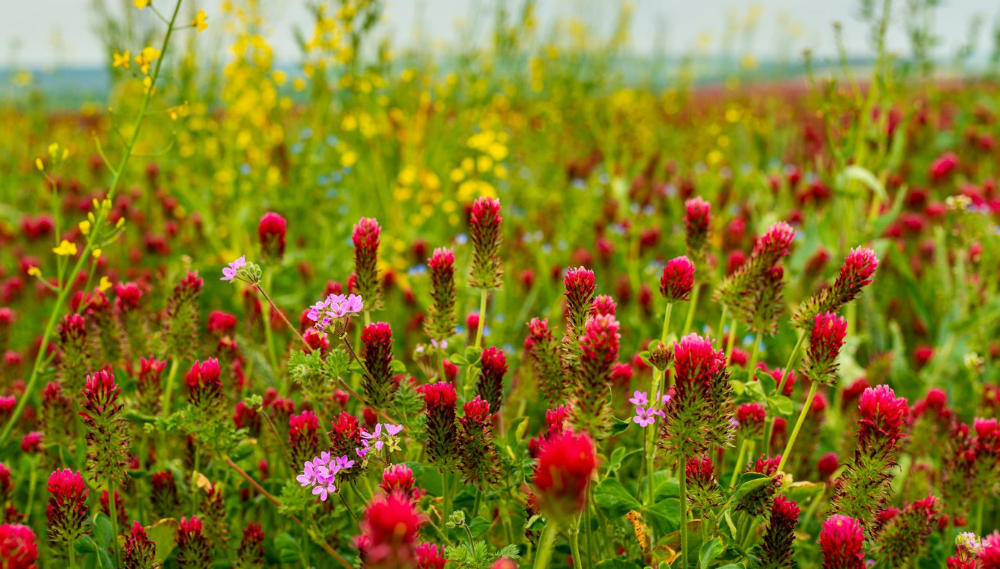
2. Cucumbers
| Common Name | Cucumbers, Garden Cucumbers |
| Botanical Name | Cucumis sativus |
| Family | Cucurbitaceae |
| Plant Type | Fruit |
| Size | 2-6 ft. tall, 1-3 ft. wide |
| Sun Exposure | Full |
| Soil Type | Moist, Well-drained |
| Soil pH | Slightly acidic |
| Bloom Time | Summer |
| Flower Color | Yellow and Green |
| Hardiness Zones | 3-8 (USDA) |
| Native Area | The Indian Subcontinent |
| Toxicity | Non-toxic |
Cucumbers and tomatoes both prefer a warm environment and share similar growing habits, so it makes sense that they make good companions.
When grown as a thick ground cover of living mulch around taller crops (like tomatoes), cucumbers serve as an excellent means of weed control by smothering the seedlings.
The downside is it could result in a smaller cucumber yield. However, cucumbers usually produce an abundant crop, so in the long run, this shouldn’t put you off growing them this way.
Tip: If you’re growing tomatoes from seed, we recommend using either crimson clover, mini clover or oats as a weed-controlling companion plant for your tomatoes.
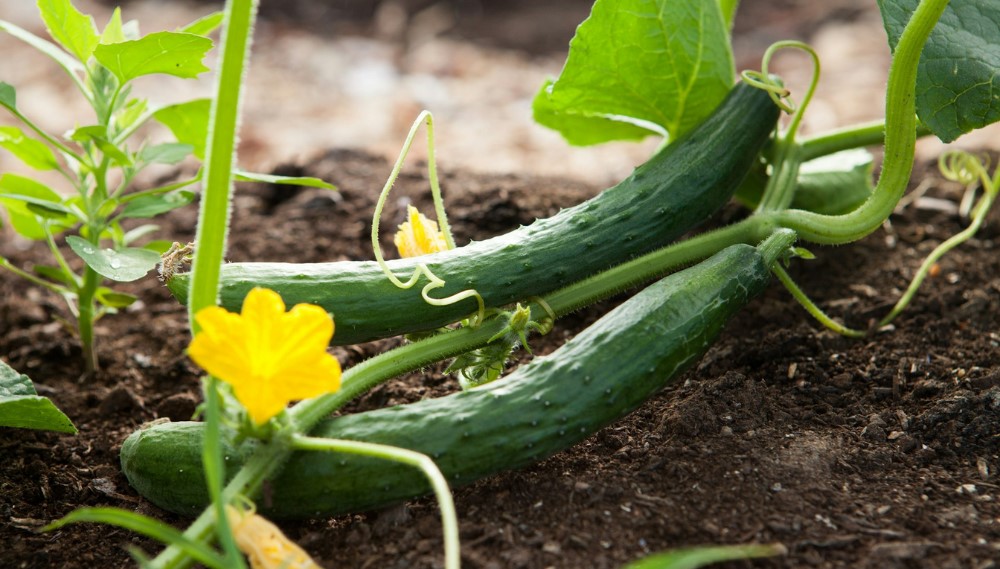
3. Oats
| Common Name | Oats, Common Oats |
| Botanical Name | Avena sativa |
| Family | Poaceae |
| Plant Type | Grass |
| Size | 3 ft. tall, 4 in. wide |
| Sun Exposure | Full |
| Soil Type | Well-drained |
| Soil pH | Acidic, Neutral |
| Hardiness Zones | 8-10 (USDA) |
| Native Area | Eurasia |
| Toxicity | Non-toxic |
Oats planted in the fall as an annual cover crop will help control the growth of weeds in your garden by preventing their seedlings from germinating in spring.
The roots will also help break down the soil and make it easier for the tomato root system to establish. This, in turn, will aid nutrient uptake, resulting in healthier tomato crops.
Furthermore, as the debris decomposes, it can be dug into the soil, adding a secondary layer of organic matter.
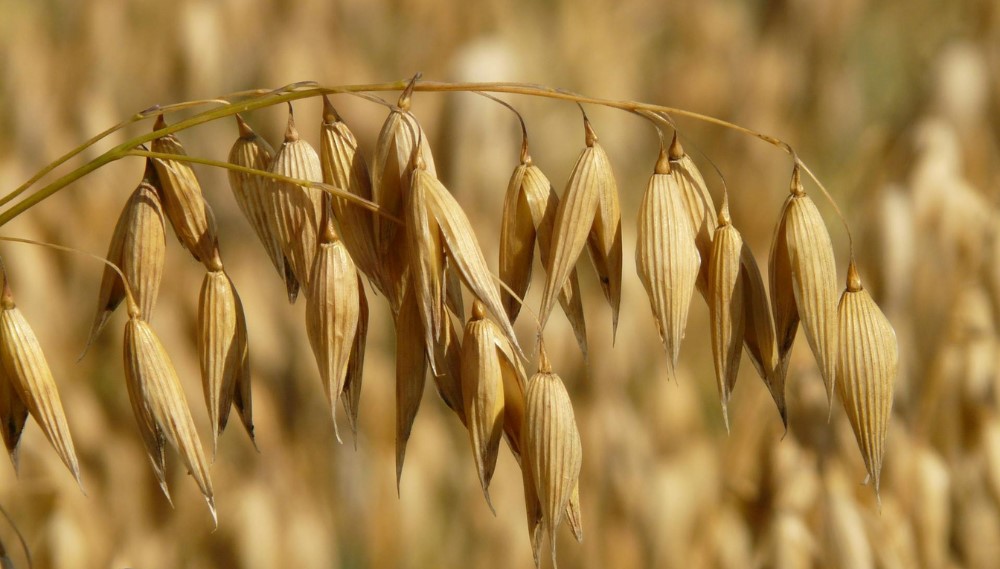
Plants That Increase Tomato Pollination
Besides weed and pest control, some companion plants help to pollinate your tomatoes. Here are three of the best flowers to help you attract pollinators to your tomato crops.
H4: 1. Lavender
| Common Name | Lavender, English Lavender, True Lavender |
| Botanical Name | Lavandula |
| Family | Lamiaceae |
| Plant Type | Shrub |
| Size | 1-2 ft. tall, 2-3 ft. wide |
| Sun Exposure | Full, Partial |
| Soil Type | Loamy, Well-drained |
| Soil pH | Alkaline, Neutral |
| Bloom Time | Summer |
| Flower Color | Purple and Violet |
| Hardiness Zones | 5-9 (USDA) |
| Native Area | The Mediterranean |
| Toxicity | Toxic to people, toxic to pets |
Many gardeners love lavender plants because they exude a sweet, powerful fragrance from both their foliage and flowerheads. Pollinators like bees, butterflies, and hoverflies also love the quality of lavender plants and actively seek out their strong scent.
Consequently, you can expect to see more pollinators around your tomato crops.
Tip: Lavender plants require dry, well-draining soil to thrive. They are best grown in pots that are located close to your tomato crops.
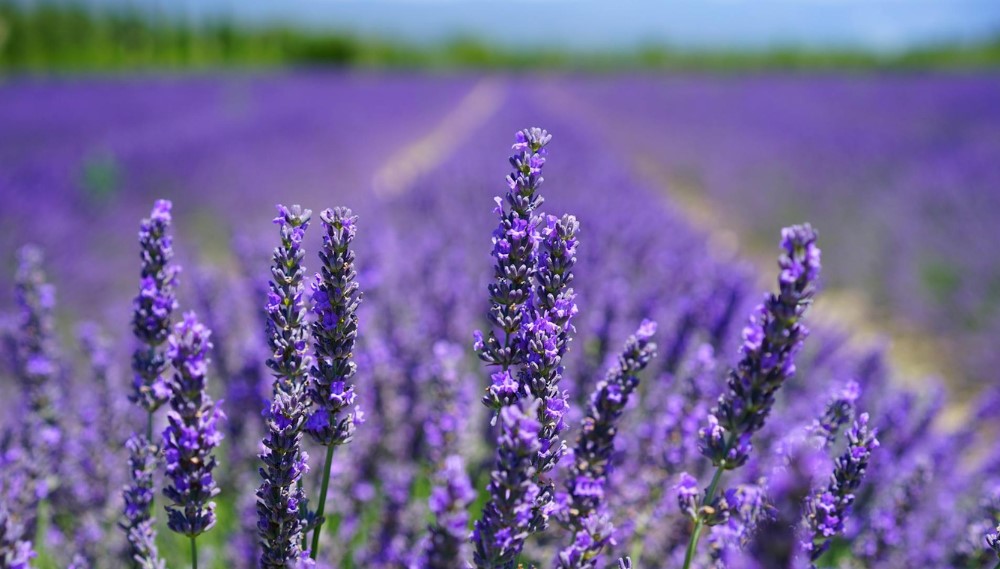
2. Cleome
| Common Name | Cleome, Spider Flowers, Spider Plants |
| Botanical Name | Cleome hassleriana |
| Family | Capparaceae |
| Plant Type | Flower |
| Size | 1.5 – 5 ft. tall, 1-2 ft. wide |
| Sun Exposure | Full, Partial |
| Soil Type | Average, Well-drained |
| Soil pH | Acidic, Neutral |
| Bloom Time | Summer |
| Flower Color | White, Pink and Purple |
| Hardiness Zones | 10-11 (USDA) |
| Native Area | South America |
| Toxicity | Non-toxic |
Cleome plants are great at attracting bees, butterflies, moths, and other pollinators to your garden; what’s more, all of those pollinators help to enrich your tomato crop.
Aside from their nectar-rich flowers, cleome plants also have prickly stems, making them rabbit-resistant. Consider growing a protective barrier of cleome plants around your tomatoes.
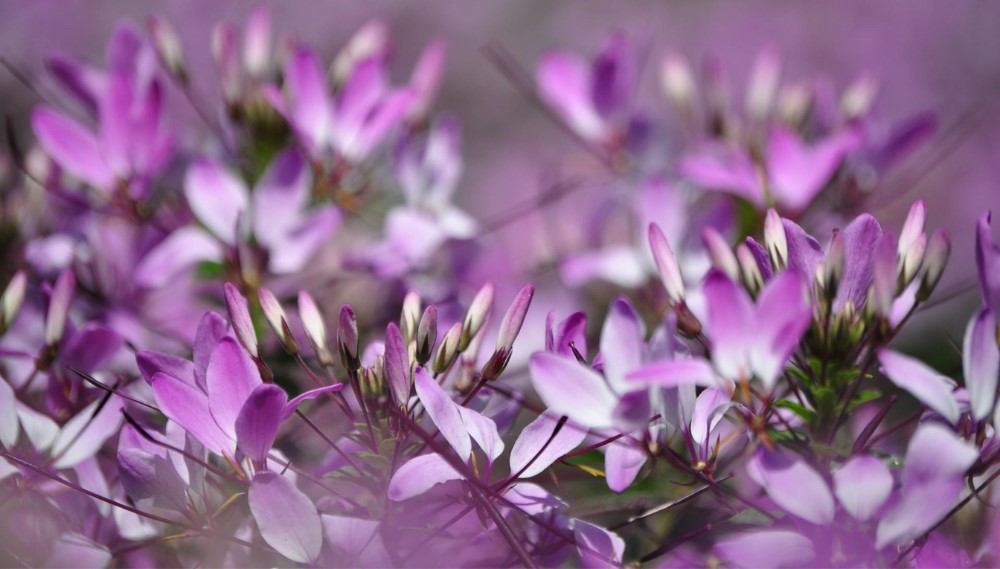
3. Sunflowers
| Common Name | Sunflowers |
| Botanical Name | Helianthus |
| Family | Asteraceae |
| Plant Type | Flower |
| Size | 1-16 ft. tall, 1-3 ft. wide |
| Sun Exposure | Full |
| Soil Type | Well-drained |
| Soil pH | Slightly Acidic, Neutral |
| Bloom Time | Summer |
| Flower Color | Yellow, Red, and Orange |
| Hardiness Zones | 4-9 (USDA) |
| Native Area | North America |
| Toxicity | Non-toxic |
Sunflowers attract a range of bee species, including bumble bees, which makes them one of the best for encouraging tomato pollination.
Birds like thrushes and blackbirds are also attracted to sunflowers, adding to the beneficial predators you need to attract to your garden. Tip: Place water stations near your tomatoes to encourage more birds.
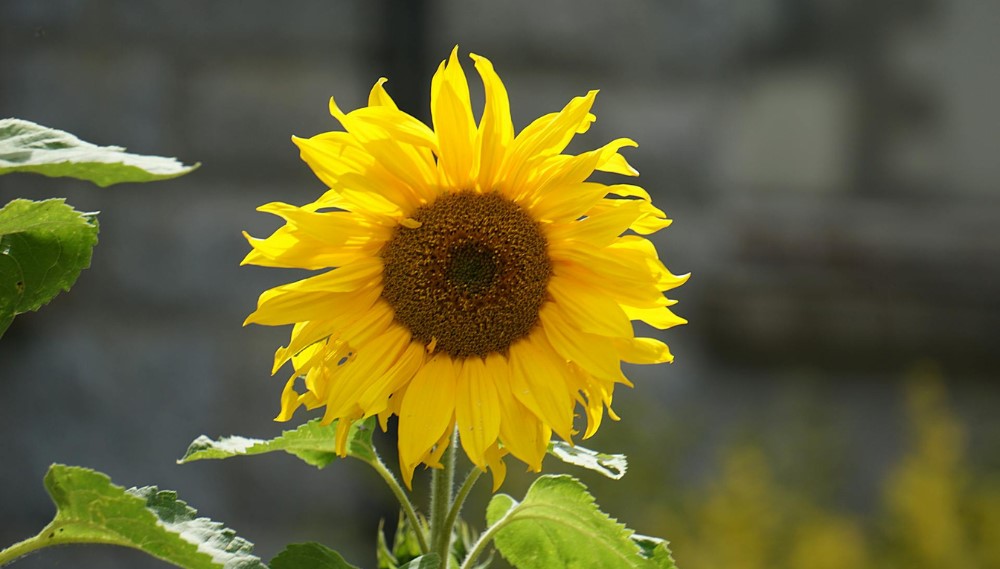
Plants That Improve Your Tomato Crops’ Health
Some companion plants directly improve the health of your crop. Here are some of the best options.
1. Beans
Both bush beans and pole beans absorb nitrogen from the atmosphere and synthesize it into a more available form.
Given that tomatoes consume large amounts of nitrogen, the beans can actively enhance the growth of your tomato crops.

2. Borage
| Common Name | Borage, Starflower, Bee Flower |
| Botanical Name | Borago officinalis |
| Family | Boraginaceae |
| Plant Type | Flowering herb |
| Size | 1-3 ft. tall, 9-18 in. wide |
| Sun Exposure | Full, Partial |
| Soil Type | Well-drained |
| Soil pH | Acidic, Neutral, Alkaline |
| Bloom Time | Summer |
| Flower Color | Blue |
| Hardiness Zones | 2-11 (USDA) |
| Native Area | The Mediterranean |
| Toxicity | Toxic to cats, dogs horses |
A borage plant’s roots will penetrate soil, ensuring adequate aeration. Therefore, planting borage plants into the soil where you intend to grow tomatoes will improve the soil quality. In addition, borage is a source of calcium, choline, and B vitamins that will improve the soil quality and enhance your tomatoes’ health.
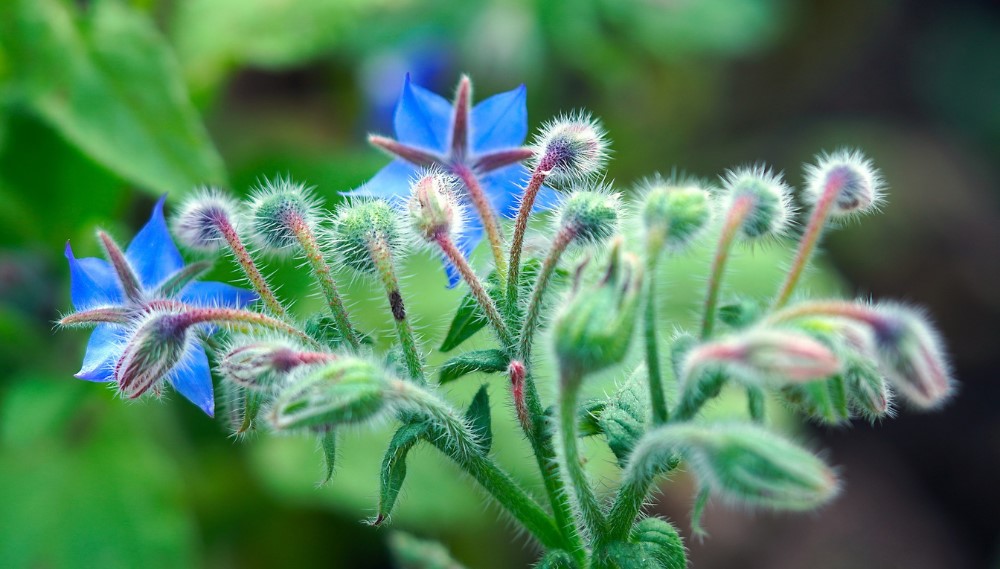
Plants That Reduce Disease in Tomatoes
It’s no secret that tomatoes are prone to a number of fungal diseases; however, the following three companion plants make it easier to protect your tomatoes from any illnesses.
1. Hairy Vetch
| Common Name | Hairy Vetch, Winter Vetch, Fodder Vetch |
| Botanical Name | Vicia villosa Roth |
| Family | Fabaceae |
| Plant Type | Legume |
| Size | 12-28 in. tall, 1-2 in. wide |
| Sun Exposure | Full |
| Soil Type | Well-drained |
| Soil pH | Neutral |
| Bloom Time | Late Spring – Mid Summer |
| Flower Color | Purple |
| Hardiness Zones | 4-10 (USDA) |
| Native Area | Europe, Northern Africa, Western Asia |
| Toxicity | Toxic to people, toxic to pets |
As a cover crop, hairy vetch makes an excellent tomato companion plant. Hairy vetch reduces foliar diseases in tomatoes, acting as a deterrent for diseases like early blight and Septoria leaf spot.
Hairy vetch is a legume, meaning it also provides additional concentrations of nitrogen to the soil around your tomato plants.
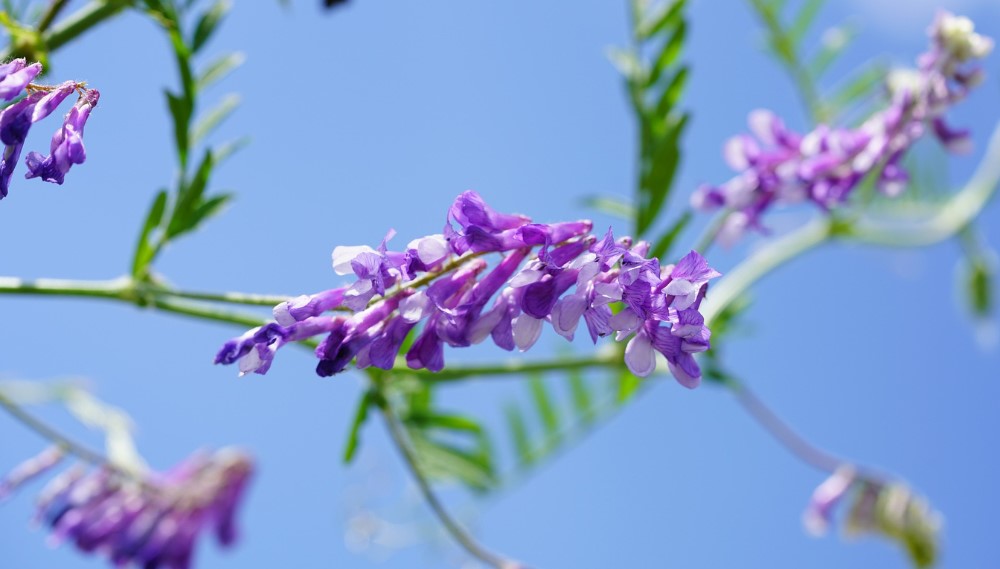
2. Garlic
| Common Name | Garlic |
| Botanical Name | Allium sativum |
| Family | Amaryllidaceae |
| Plant Type | Vegetable |
| Size | 18 in. tall, 4 in. wide |
| Sun Exposure | Full |
| Soil Type | Moist, Well-drained |
| Soil pH | Neutral |
| Bloom Time | Spring – Summer |
| Flower Color | White and Purple |
| Hardiness Zones | 2-6 (USDA) |
| Native Area | Central Asia |
| Toxicity | Toxic to pets |
Garlic has antifungal and antibacterial properties, acting as the perfect natural remedy for soil-borne diseases that affect tomatoes, like fusarium wilt.
It also releases a powerful scent that can deter harmful pests that can carry diseases to your tomatoes and other crops you might be growing.
It is also a well-known edible plant that is widely used in various culinary dishes. It is a great oversight not to grow garlic amongst your tomatoes or other vegetables.
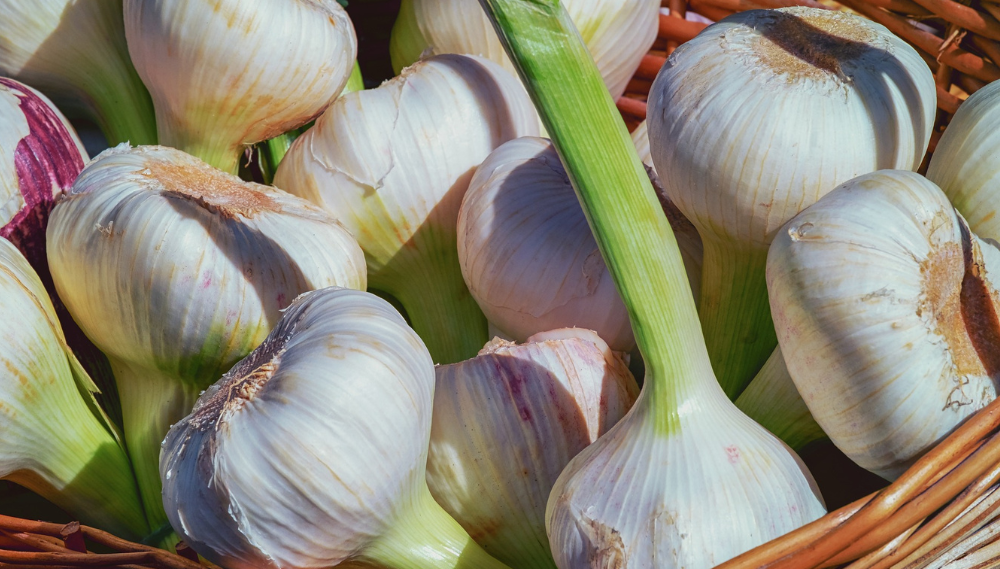
3. Asparagus
| Common Name | Asparagus, Garden Asparagus, Sparrow Grass |
| Botanical Name | Asparagus officinalis |
| Family | Asparagaceae |
| Plant Type | Vegetable |
| Size | 4 ft. tall, 2 ft. wide |
| Sun Exposure | Full |
| Soil Type | Sandy, Loamy |
| Soil pH | Acidic, Neutral |
| Bloom Time | Summer – Autumn |
| Flower Color | Yellow and Green |
| Hardiness Zones | 3-10 (USDA) |
| Native Area | Europe and Africa |
| Toxicity | Berries are toxic to humans |
Not only is asparagus an edible, delicious crop, but it is also an excellent companion plant for tomatoes.
Asparagus produces a toxic compound that deters root-knot nematodes, which are known to attack the root systems of nightshades like tomatoes. As a result, asparagus can prevent chlorosis, stunting, and wilting in tomato crops.
Asparagus also produces a natural fungicide that can help prevent early blight and botrytis.

The Best Tomato Companion Plants: Concluding Thoughts
In a small space and with very little maintenance, you can produce a bountiful harvest of deliciously ripe tomatoes by using companion plants.
Be sure to carefully choose tomato companion plants based on their benefits to your main crop, especially if you only have a limited space.
For more advice on vegetable gardening and plant care, feel free to check out our blog!
Frequently Asked Questions
Our most frequently asked questions that relate to tomato companion plants.
1. Which companion plants should I avoid growing near my tomatoes?
Avoid growing the following plants near your tomato crops:
- Brassicas.
- Corn.
- Fennel.
- Dill.
- Other nightshade plants.
- Rosemary.
Brassicas, fennel, and dill all inhibit a tomato plant’s growth. Corn attracts corn earworms, which also eat tomatoes. Rosemary depletes the soil nutrients that you need to grow tomatoes. Other nightshade plants like peppers and potatoes are all susceptible to early and late blight, which can spread to your tomatoes.
2. Can I plant multiple tomato plants next to one another?
Tomatoes require a generous amount of space to grow effectively. For this reason, we don’t recommend growing several tomato plants in close proximity to each other. Instead, try to ensure at least two feet between each plant.
3. Can you plant carrots and tomatoes next to each other?
As carrots grow, they often break up the soil. When this happens, essential nutrients, water, and oxygen permeate the roots of any neighboring tomato plants. As a result, carrots make excellent tomato companion plants.
4. How do I keep rodents off my tomato plants?
Unfortunately, companion plants won’t protect against rodents like squirrels and chipmunks. If your tomato crops are getting regular visits from critters, it’s a good idea to invest in either chicken wire, plastic mesh fencing, or lightweight bird netting. A light barrier or fencing around your tomato crops can ensure that they are better protected against larger critters.